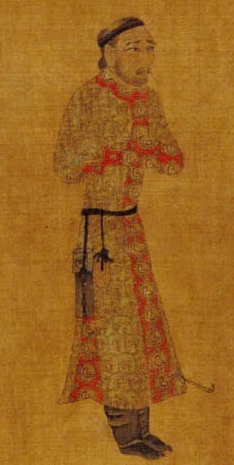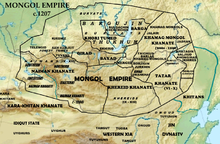
The Tangut people were a Sino-Tibetan people who founded and inhabited the Western Xia dynasty. The group initially lived under Tuyuhun authority, but later submitted to the Tang dynasty. After the collapse of Tang dynasty, the Tanguts established the Western Xia. They spoke the Tangut language, which was previously believed to be one of the Qiangic languages or Yi languages which belong to the Tibeto-Burman family." Phylogenetic and historical linguistic accounts, however, reveal that Tangut belonged instead to the Gyalrongic branch of Tibeto-Burman. Western Xia was annihilated by the Mongol Empire in 1227, most of its written records and architecture were destroyed. Today the Tangut language and its unique script are extinct; only fragments of Tangut literature remain.

The Xianbei were an ancient nomadic people that once resided in the eastern Eurasian steppes in what is today Mongolia, Inner Mongolia, and Northeastern China. The Xianbei were strongly suggested to be a multilingual, multi-ethnic confederation consisting of mainly Proto-Mongols, and, to a minor degree, Tungusic and Turkic peoples. They originated from the Donghu people who splintered into the Wuhuan and Xianbei when they were defeated by the Xiongnu at the end of the third century BC. Following the split, the Xianbei people did not have a direct contact with the Han dynasty, residing to the north of the Wuhuan. In the first century BC, the Xianbei began to actively engage in the struggle between the Han and Xiongnu, which culminated in the Xianbei replacing the Xiongnu on the Mongolian Plateau in 93 AD.

The Monguor, the Tu people, the White Mongol or the Tsagaan Mongol, are Mongolic people and one of the 56 officially recognized ethnic groups in China. The "Tu" ethnic category was created in the 1950s.
Khagan or Qaghan is a title of imperial rank in Turkic, Mongolic, and some other languages, equal to the status of emperor and someone who rules a khaganate (empire). The female equivalent is Khatun.

Songtsen Gampo, also Songzan Ganbu, was the 33rd Tibetan king of the Yarlung dynasty and the founder of the Tibetan Empire. The first of three Dharma Kings of Tibet, he formally introduced Buddhism to Tibet and built the Jokhang with the influence of his Nepali queen Bhrikuti, of Nepal's Licchavi dynasty. He unified several Tibetan kingdoms, conquered lands adjacent to Tibet, and moved the capital to the Red Fort in Lhasa. His minister Thonmi Sambhota created the Tibetan script and Classical Tibetan, the first literary and spoken language of Tibet.

Murong (Chinese: 慕容; pinyin: Mùróng; Wade–Giles: Mu4-jung2; LHC: *mɑC-joŋ; EMC: *mɔh-juawŋ) or Muren refers to an ethnic Xianbei tribe who are attested from the time of Tanshihuai (reigned 156–181). Different strands of evidence exist linking the Murong to the Mongols nomadic confederation in Central Asia. The Former Yan (337–370), Western Yan (384–394), Later Yan (384–409) dynasties as well as Tuyuhun (285–670) were all founded by the Murong peoples.

Songpan County, former Songzhou, is a county of northwestern Sichuan province, China, and is one of the 13 counties administered by the Ngawa Tibetan and Qiang Autonomous Prefecture. It has an area of 8,486 square kilometres (3,276 sq mi), and a population of approximately 68,000 composed of Tibetan, Qiang, Han and Hui populations.

Hou Junji was a Chinese general and official who served as a chancellor during the reign of Emperor Taizong in the Tang dynasty. He is best known for leading the Tang military campaigns against the Gaochang and Tuyuhun kingdoms. In 643, he was implicated in a plot by the crown prince, Li Chengqian, to overthrow Emperor Taizong, and was executed.

Emperor Taizong of Tang, the second emperor of the Tang dynasty faced challenges throughout his reign from Tang's western neighbor, the state of Tuyuhun, whose Busabuo Khan Murong Fuyun constantly challenged Tang authority in the border regions. In 634, Emperor Taizong launched a major attack, commanded by the major general Li Jing, against Tuyuhun, dealing Tuyuhun forces heavy defeats and causing Murong Fuyun's subordinates to assassinate him in 635. Tuyuhun, thus weakened, no longer remained a major power in the region, and while Tang, ironically, played the role of protector for Murong Fuyun's son, the Gandou Khan Murong Shun, and grandson, the Ledou Khan Murong Nuohebo, Tuyuhun was never able to recover, particularly with its southwestern neighbor, the Tibetan Empire, constantly attacking it. By 672, during the reign of Emperor Taizong's son Emperor Gaozong of Tang, Tang was forced to move Tuyuhun remnants into its own territory, ending Tuyuhun.
The first military conflict between China and Tibet occurred in 638. In the early 7th century, the westward conquests of the Tang dynasty brought it into contact with the rising Tibetan Empire. When Emperor Taizong of Tang refused a marriage alliance, the Tibetan emperor Songtsen Gampo sent an army to attack the Chinese frontier city of Songzhou. After a Tang army inflicted heavy casualties on the Tibetans in a night-time attack, Songtsen Gampo withdrew. He sent emissaries and tributes to Chang'an to apologize, and to again request marriage. Taizong decided to give Songtsen Gampo a distant niece, Princess Wencheng, in marriage. The peace held for the remainder of the reigns of Taizong and Songtsen Gampo, although Tibet would pose major military threats for most of the rest of the Tang period.
Murong Fuyun, regnal name Busabo Khan, was a ruler of the Xianbei-led dynastic state of Tuyuhun. He first became ruler when his brother Murong Shifu was assassinated in 597, and became one of the longest-ruling monarchs of Tuyuhun. His reign was characterized by numerous major conflicts with the Sui and Tang dynasties. In 635, during a Tang invasion, he was assassinated due to the people's resentment of his hostile attitude toward the Emperor Taizong of Tang that led to the invasion.
Murong Nuohebo, regnal name Wudiyebaledou Khan (烏地也拔勒豆可汗) or, in short, Ledou Khan (勒豆可汗), Tang dynasty noble title Prince of Qinghai (青海王), was the last khan of the Xianbei-ruled Tuyuhun state. He had become khan in 635 after his grandfather, the Busabo Khan Murong Fuyun and his father, the Gandou Khan Murong Shun, had both been killed in the same year: Murong Fuyun during a Tang invasion and Murong Shun assassinated by his own people in the aftermaths of the Tang conquest. Murong Nuohebo's control over his people was initially tenuous and required Tang military affirmation on at least two occasions, but once his control was firmer, he faced the threat of Tibetan Empire to the south-west. In 663, unable to stand Tibetan pressure, he took his people and requested refuge in Tang territory, and by 672, the Tibetan Empire had taken over all of former Tuyuhun territory. The Tuyuhun people were settled within Tang territory, and Murong Nuohebo was made a Tang prefect. While he continued to carry the title of khan until his death in 688, typically, Tuyuhun was considered destroyed by either 663 or 672.

The Tibetan Empire was an empire centered on the Tibetan Plateau, formed as a result of imperial expansion under the Yarlung dynasty heralded by its 33rd king, Songtsen Gampo, in the 7th century. The empire further expanded under the 38th king, Trisong Detsen, and expanded to its greatest extent under the 41st king, Rapalchen, whose 821–823 treaty was concluded between the Tibetan Empire and the Tang dynasty. This treaty, carved into the Jokhang Pillar, delineated Tibet as being in possession of an area larger than the Tibetan Plateau, stretching east to Chang'an, west beyond modern Afghanistan.

During Tang dynasty rule in China (618–907), a complex relationship between imperial China and Tibet regime was developed. During this period Chinese and Tibetan forces had many battles since both parties were military powers, but there were also years of peace and friendly relations.
The Upper Mongols, also known as the Köke Nuur Mongols or Qinghai Mongols, are ethnic Mongol people of Oirat and Khalkha origin who settled around the Qinghai Lake in so-called Upper Mongolia. As part of the Khoshut Khanate of Qaidam Basin and the Qinghai Lake, they played a major role in Sino–Mongol–Tibetan politics during the 17th and 18th centuries. The Upper Mongols adopted Tibetan dress and jewelry despite still living in the traditional Mongolian ger and writing in the script.

The Tibetan Annals, or Old Tibetan Annals (OTA), are composed of two manuscripts written in Old Tibetan language found in the early 20th century in the "hidden library", the Mogao Grottoes near Dunhuang in northwestern Gansu province, Western China, which is believed to have been sealed in the 11th century CE. They form Tibet's earliest extant history.

Gar Tongtsen Yulsung was a general of the Tibetan Empire who served as Lönchen during the reign of Songtsen Gampo. In many Chinese records, his name was given as Lù Dōngzàn or Lùn Dōngzàn ; both are attempts to transliterate the short form of his title and name, Lön Tongtsen.
Para-Mongolic is a proposed group of languages that is considered to be an extinct sister branch of the Mongolic languages. Para-Mongolic contains certain historically attested extinct languages, among them Khitan and Tuyuhun.
Tuyuhun, also known as ‘Azha from Tibetan script, is an extinct language once spoken by the Tuyuhun of northern China about 500 AD. The existence of the Tuyuhun, and consequently their language, is first attested in the Book of Song, compiled around 488 AD.
Serbi–Mongolic is a proposed group of languages that includes the Mongolic languages as well as the Para-Mongolic languages, a proposed extinct sister branch of the Mongolic languages.

















